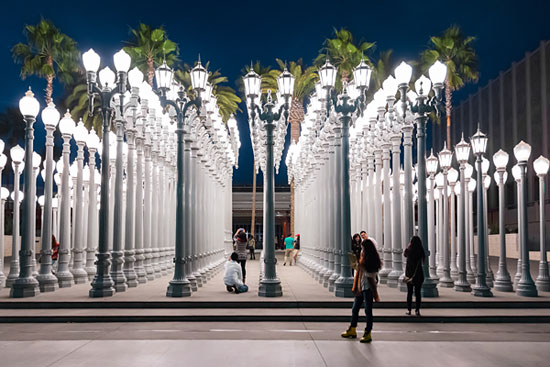As LACMA grows, economy lights up
January 23, 2014
There’s art that enriches the soul and there are investments that boost the bottom line. And then there’s the Los Angeles County Museum of Art, which has embarked on a “Transformation” campaign that—in addition to creating new galleries and installing epic works of art like “Urban Light” and “Levitated Mass”—generated more than $477 million in economic benefits for L.A. County, a new report finds.
The report by the Los Angeles County Economic Development Corporation, commissioned by the museum and being released today, studied visitor patterns and the direct and indirect impacts of building new destinations on the LACMA campus, ranging from the Broad Contemporary Art Museum and the Resnick Pavilion to Ray’s and Stark Bar.
Overall, the museum spent $269 million over nine years to complete the first two phases of the three-part initiative, with about $30 million coming from Los Angeles County and the rest from donors.
It was money well spent, the study found. In addition to generating economic output of more than $477 million, it supported 3,650 jobs—1,300 of them ongoing and not directly related to the construction itself—and contributed to an additional estimated $22 million in state and local taxes and $41.7 million in federal taxes.
The benefits don’t stop there, said Christine Cooper, the study’s lead author. “It’s going to keep on coming back,” she said, noting that researchers estimate that $255 million in continuing economic activity flows from the new-and-improved LACMA each year, plus state and local taxes of $11 million.
“LACMA’s Transformation demonstrates how public investment and private philanthropy can together create a larger overall benefit to Los Angeles County,” the report said. It noted that the county investment “will be repaid in tax revenues to the county within just a few years” because of all the resulting economic activity.
During the course of the campaign, museum attendance has more than doubled, reaching over 1.2 million visitors last year. And the museum’s visibility on the local, national and international scene has grown as well, with the arrival of LACMA director and CEO Michael Govan in 2006. Chris Burden’s much-photographed “Urban Light,” one of the artistic hallmarks of LACMA’s growth initiative, has become an instantly recognizable icon to passersby and museum-goers alike. And the slo-mo, 105-mile journey of the 340-ton boulder that plays the starring role in Michael Heizer’s “Levitated Mass” created a populist, communal sensation across the Southland and beyond.
The two phases of the initiative completed so far have “elevated the museum’s cultural standing to gain national and global recognition as a center of arts and entertainment,” the report said.
LACMA continues to draw the majority of its visitors from California, mostly from the Los Angeles region. However, the number of international visitors and those from other states grew from 11.5% in fiscal 2007 to 16% in fiscal 2013, the report said. “This shift in the origin of museum attendees is evidence of the growing international reputation of the museum and of the Los Angeles region and its global draw,” it found.
That’s economically significant, the report said, because visitors from outside the region tend to spend more when they visit—on gift shop purchases, food and drink, and other items. The benefit also goes beyond the museum itself; LACMA’s out-of-town visitors paid for accommodations, transportation, entertainment and meals around the area to the tune of $29.1 million in fiscal 2013—nearly three times as much as they spent in fiscal 2007.
The third phase of the “Transformation” initiative focuses on the east side of the LACMA campus. A proposed new signature building by Pritzker Prize-winning architect Peter Zumthor is in the planning phases.
The changes so far have had a remarkable impact, one that promises to endure, said Los Angeles County Supervisor Zev Yaroslavsky.
“Over the past seven years, LACMA has evolved into a thriving center of cultural activity,” Yaroslavsky said in a statement. “LACMA’s success is an example of a private/public partnership that will offer economic and educational benefits for years to come.”
Posted 1/23/14















 405 bridge work causes a stink
405 bridge work causes a stink